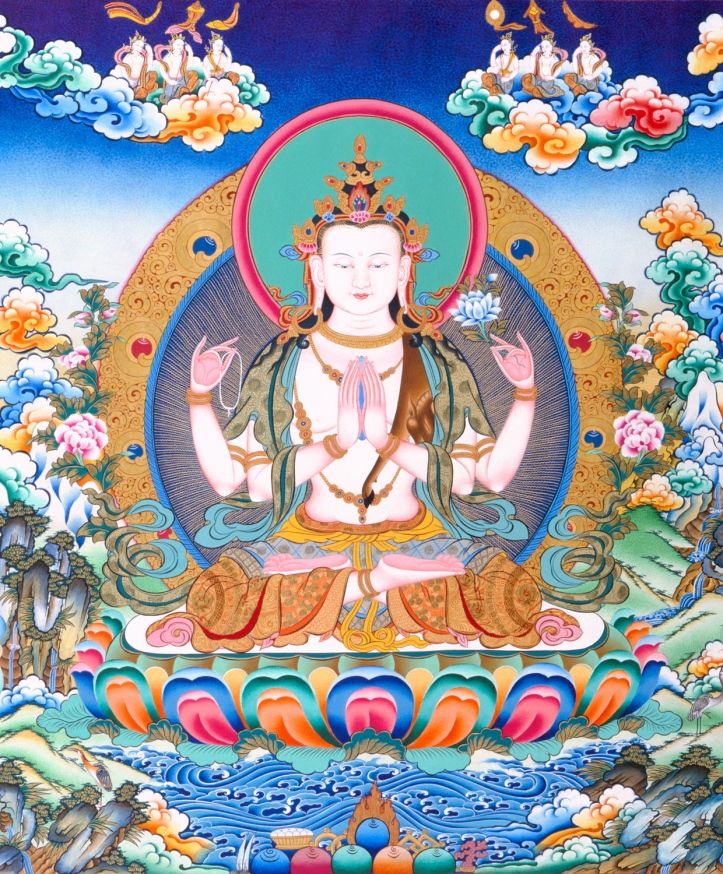When choosing a meditation practice, it is highly recommended to have an experienced meditation teacher for guidance.
The following information is extracted from Namgyal Rinpoche’s “Introduction to Meditation”
The 7 Types of Meditation
- Breathing
- Visualization
- Point (or chakra)
- Sound (mantra)
- Movement (mudra)
- Devotional
- Direct essence of mind
The first six meditations listed are Samatha (sam-a-ta) or Tranquility (bliss) meditations, while the seventh is Vipassana (we-pass-a-na) or Insight Meditation.
The difference between the two is that the former leads to blissful absorption on the object of meditation, known as a state called Jhana. Keep in mind when you hear the word “bliss” that a meditative state is temporary and therefore still in the realm of suffering. If we come out of Jhana and want to get back it can be painful. on the object of meditation
The latter, Vipassana meditation, results in “the direct seeing of the nature of mind, and therefore leads to knowledge”. For those who are familiar with S.N. Goenka’s 10-day Vipassana retreats, please know that the body-scanning is just one type of Vipassana meditation.
In fact, the two types of meditation [Samatha and Vipassana] are not separate, except in their early stages, as all the Samatha meditations are designed to pass into Insight. Samatha is involved with the calming of the mind so that when knowledge does come through it can be faced without a buffer and the consciousness does not rebound into psychically unwholesome states. All Buddhist meditations end in Insight, and the permanent calm that is finally won through meditation is called Nirvana.
 Practice 1: Visualization Bliss Meditation
Practice 1: Visualization Bliss Meditation
For a simple exploration of bliss meditation, find a flower in your home, or go out and buy one. Sit before the flower for five minutes. Start this meditation by studying the flower.
2 minutes: For two minutes consider: How does the flower make you feel? What details do you notice about the flower? Study the flower carefully. If your mind wanders, which it will, gently bring it back to the flower.
1 minute: After two minutes, close your eyes for a minute. Bring back the feeling and image of the flower to your mind, and keep it with you. Again if your mind wanders, simply bring it back.
1 minute: After a minute, open your eyes again and study the flower again: its feeling, its visual appearance.
1 minute: Close your eyes for the final minute and try imagining the flower again, the feeling you get from it, its appearance.
 Practice 2: Mantra Bliss Meditation
Practice 2: Mantra Bliss Meditation
Sit for six minutes:
2 minutes: Repeat the mantra “OM” and imagine the colour white at the forehead.
2 minutes: Repeat the mantra “AH” and imagine the colour red at the throat.
2 minutes: Repeat the mantra “HUM” and imagine the colour blue at the heart.
Was there a different feeling in the body/ mind while saying each syllable?
 Practice 3: Deity Bliss Meditation
Practice 3: Deity Bliss Meditation
This is a more advanced meditation. Please be advised that it is encouraged to have a teacher, initiation Wong Kur, and Sadhana text for fuller practice of Chenrezig. It is advised not to attempt any deity work other than Chenrezig and Vajrasattva without a teacher to guide you.
Deity practice is an excellent experience of bliss, or Samatha, meditation because it involves visualization, chakra, mudra, mantra, and the devotional aspects of meditation.
You may look at the below image of Chenrezig, the Tibetan pictorial for the deity of Compassion, or you can create your own imaginary being who exemplifies the qualities of compassion.
With Chenrezig we begin the meditation with saying “Om Ah Hum” and imagining white coming out of the forehead, red from the throat, and blue from the heart (chakra points). Chenrezig is the union of these three.
Chenrezig holds their four hands in the mudra seen below and is seated in the lotus posture. The meditator can copy these gestures the best they can, and supplement with imagination.
With Chenrezig, the mantra “Om Ma Ni Pad Me Hum” is said aloud while following the beads of a mala. You can also create your own mantra in English, however in Tibet is taught that there are “seed syllables” such as used in the Chenrezig mantra that have a certain effect on our unconscious.

 Practice 4: Insight Meditation
Practice 4: Insight Meditation
After having experienced some form of bliss meditation above, compare the experience by doing a 10 minute Insight, Vipassana meditation.
Sit comfortably and begin by lightly following your breath at the nostrils.
Say the following question in your mind, all the while following your breath:
“What is my area of growth right now?” Alternatively, you can create your own question.
Hold the question, following your breath, and imagine dropping the question into the depth of your being, like dropping a stone down a well or into a pond.
Continue sitting for the remainder ten minutes, gently following your breath. Do not focus on your thoughts, but if a thought or image comes up in response to the question asked, take note of it and gently return to the breath.
At the end of the sit, review your meditation. Were there any insights to your question?
[…] are two categories of meditation, and vipassana is one of […]
LikeLike